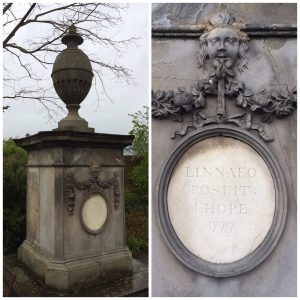 In just a few weeks work will have begun on the rebuilding of the Botanic Cottage, the only surviving building of the long lost 18th century incarnation of the Royal Botanic Garden Edinburgh which once stood on Leith Walk. However, one handsome monument which was a prominent feature of the garden on Leith Walk was moved across the city when the Botanics came to their present site in Inverleith in the 1820s: the Linnaeus Monument.
In just a few weeks work will have begun on the rebuilding of the Botanic Cottage, the only surviving building of the long lost 18th century incarnation of the Royal Botanic Garden Edinburgh which once stood on Leith Walk. However, one handsome monument which was a prominent feature of the garden on Leith Walk was moved across the city when the Botanics came to their present site in Inverleith in the 1820s: the Linnaeus Monument.
Today it is somewhat hidden behind the 1960s glasshouse range, but at one time it stood centre stage in the garden created by Regius Keeper John Hope. Hope was an admirer of Carl Linnaeus, a great Swedish botanist who established principles for naming plants which proved highly influential. The pair corresponded and Hope put some of Linnaeus’ ideas into practice in the Leith Walk garden. Upon the latter’s death in 1778, John Hope decided to erect a monument to this pioneering figure.
Hope wrote of the monument:
‘The design of the Monument I erected to Linnaeus was given me by Mr. [Robert] Adams [sic] and it was executed by your acquaintance Mr. Craig who gave the plan of the new Town.’
Therefore the most important architect of the 18th century, Robert Adam, was responsible for the design of this memorial, and its execution was by Thomas Craig, the man who designed the winning layout of Edinburgh’s New Town – quite a dream team! Several other designs had been done by Adam, including more elaborate ones, but the finished version, unveiled in 1779, is an example of restrained elegance.
Hopefully in the not too distant future the Linnaeus monument will find a new home in a more visible area of the Royal Botanic Garden Edinburgh, enabling more people to see the work of master craftsmen, to remember the contribution to botany by Carl Linnaeus, and to discover more of the stories of the lost garden on Leith Walk.
To find out more about Carl Linnaeus and John Hope, see the book ‘John Hope: 1725-1786’, revised and updated by H.J. Noltie.

2 Comments
2 Pingbacks